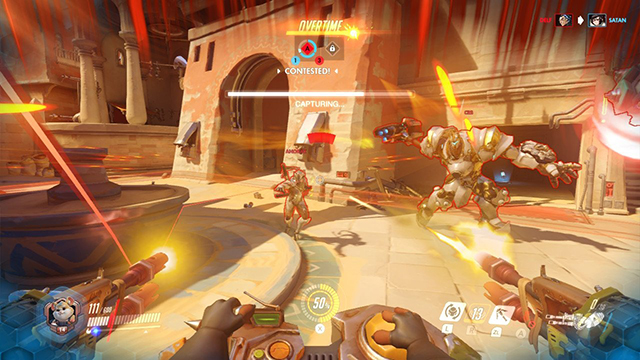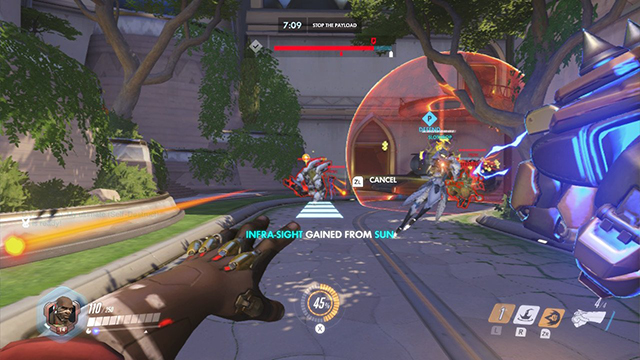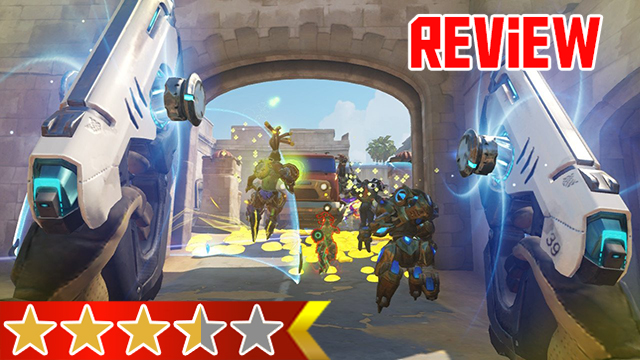The Switch playerbase has an unprecedented penchant for ports. Any game that’s worth a damn — and several that aren’t — probably has a petition on the internet begging for a version on Nintendo’s newest system. OVERWATCH, Blizzard’s premier online team-based game that launched in 2016, was probably on that list and has finally been willed into existence. Even nearly three-and-a-half years later, it’s still one of the best multiplayer experiences ever created, benefiting from Blizzard’s sublime design and regular slew of positive changes. But that doesn’t mean the Overwatch Switch port is the best way to appreciate those positive qualities.
A decent portion of those positive qualities have transitioned well to the platform. Team-based multiplayer battles are still tense and rewarding because of the litany of unique heroes. Mixing and matching the abilities of each character yields a different experience every time and that continual sense of discovery and strategic depth is at the very core of Overwatch‘s addictive formula. Hero limits, the endorsements system, every balance change, the recently released Role Queue, and more put this version in a particular position to launch in a healthier, more balanced state that the other platforms had to wait years for. Blizzard’s impeccable multiplayer design still reigns from above supreme because of all these changes as well as the excellent foundation these updates sit on.
ALSO: Overwatch Switch Cross-Play | Is there cross-platform play?
But that’s not the only aspects that has been translated to the Switch. In a similar way that World of Warcraft has withstood the test of time, Overwatch‘s visuals and expressive animation don’t need much fidelity to flourish. Characters squash and stretch to sell its cartoonish style and are brimming with personality that’s all too rare in multiplayer titles. There are some comparatively sparser environments and it obviously lacks the exact graphical prowess of its older siblings, but it still looks great because of its art direction. The step down, especially during more hectic moments and while playing on the big screen, is noticeable but not as noticeable as it should be.
Overwatch Switch Review | Build it up, break it down… but mostly the latter

The frame rate, however, is. Overwatch runs at a smooth 60 frames per second on both consoles and possibly higher on PC. It’s almost essential for a competitive game like this as responsiveness is what matters most online. Overwatch on the Switch runs at half that frame rate, which is serviceable but an objective step down. It doesn’t feel as smooth nor does it completely ruin the game, but it will occasionally drop frames when teams are clouding the screen with devastating ultimates. Slight slowdown doesn’t happen every match yet it’s hard not to compare it to its technically superior siblings that almost never get choppy despite the action.
Although you can’t compare the gyro controls to the other versions because it’s one of the few Switch exclusive features. Players can tilt the console or controller in multiple different ways in order to finesse the crosshair and add those minute touches analog sticks don’t allow. There are a ton of different options that let you customize the sensitivity but regardless of the avalanche of tweakable settings, it’s not a viable control scheme in most scenarios. A tiny amount of input lag from the motion controls means tracking opponents is harder than it should be, especially while moving and trying to get a bead on fast, slender characters like Tracer or Genji.
That lag hamstrings almost every character except for Bastion’s immobile turret mode, who benefits from being stationary and doesn’t require the pinpoint accuracy the other characters do. Some might overcome the input delay and prefer these tilt controls, but they aren’t precise enough and stack on the Switch’s already limited default controllers. Those tiny analog nubs don’t give players enough mobility to begin with, even considering the wealth of admittedly welcome options you can adjust.
Overwatch Switch Review | Crossing off cross-progression

Less than ideal controls may or may not be part of the reason it can’t play with other consoles. Lacking cross-play isn’t the most egregious oversight (at least for now, during the game’s peak), but not having cross-progression is harder to accept. Many are likely picking up Overwatch on the Switch as a secondary version to play more casually and those people likely have earned a ton of cosmetics over the years. Losing all of that is heartbreaking because of the amount of time and effort these skins, emotes, victory poses, sprays, player icons, and highlight intros take to acquire. Transferring items over multiple versions is probably possible — the platform-agnostic BlizzCon unlocks give some credence to that — and the inability for the Switch version to throw returning players a bone and unlock those hard-earned cosmetics is discouraging.
Forcing players to rebuild their cosmetic collection makes even less sense when looking at how the game is positioned. Given its undeniable inferiority, it lives more as a companion piece to other versions because its portability is the draw — an aspect that comes at the cost of its competitive viability. That downside doesn’t happen to some Switch ports but given the ongoing liveliness of Overwatch on other platforms, losing progress when coming to this particular version is a disappointing setback.
Overwatch on the Switch is still Overwatch, meaning that its newly added flaws are easier to forgive because of the sheer quality of the base experience. It has the same creatively designed cast that all play differently and a vibrant art style with fluid animation that’s all wrapped up in Blizzard’s signature impeccable presentation. Any form of the game is going to have that and why this slightly hobbled iteration remains a blast on a fundamental level. And while this specific iteration is mostly portable — its biggest selling point — that might not be enough to categorically forgive all of the sacrifices it had to make to jump to the platform. A lower frame rate and less accurate controls come at the cost of portability and result in a version that is a moderately tougher sell than it should be. Like a hero with an arm tied behind their back, Overwatch on the Switch still puts up a good fight. But this scaled-down port makes it a little easier to question whether or not the world needs more hamstrung heroes like this or not.
GameRevolution reviewed Overwatch on the Nintendo Switch with a code provided by the publisher.
-
Still the same fantastic team-based online shooter.
-
Smooth online play with a ton of content.
-
Colorful visuals and lively animation translate well to the Switch.
-
Whole host of control options.
-
But the game’s controls still lack accuracy, with or without gyro aiming.
-
No ability to transfer progress from other systems.
-
Frame rate can dip below 30 frames per second, which is already half of the other versions.







